

E-mails. Voice mails. Text messages. Today, you have the capability to reach people at any moment. Unfortunately, this miracle of modern communication means that everyone can reach you just as easily. The stress that this adds to daily life seems like a steep price to pay for today’s technological advancements.
Is it any surprise, then, that some days all you want to do is escape from the constant jangling of your cell phone to a place where no one can bother you?
Enter the master bathroom, the one room in the house where seclusion still reigns supreme. Even in today’s high-style homes - increasingly designed for public display and admiration - the master bath is for your eyes only.
In the not-too-distant past, bathrooms were strictly utilitarian. Today, many homeowners are building master baths with all the accoutrements of a luxurious hotel or spa. This upscale trend is far more than an extravagant indulgence; it’s a wise investment in one’s health, happiness, and well-being. A beautiful master bathroom is a sanctuary where you can fortify your mind and body in order to meet the rigorous demands of contemporary life.
The first step in creating the grand master bath of your dreams is to compile a wish list. What does your fantasy bathroom look like? Do you imagine a romantic setting, complete with soaking tub, scented candles, and soft mood lighting? Or would you prefer a peaceful place to practice your yoga poses before jumping into a bracing steam shower? Perhaps your idea of sybaritic perfection is to sip your first cup of coffee, watch the morning news, and check the day’s stock prices, all from the comfort of a bubbling spa tub.
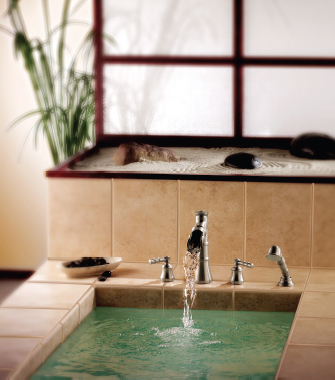
Nothing soothes the soul like Mother Nature. For maximum comfort, think light and bright, and let simple elements like water and space define your bath’s ambience.

Positioning a tub to take advantage of natural light, makes a daily bath a delightful treat.
Think about a bathroom you enjoyed while vacationing at a resort or spa. What impressed you most? Was it the heated floors? The towel warmers? The two-person shower with personalized water-temperature controls? The generous vanity and storage space? Or was it the elegant little extras, such as a built-in magnifying mirror, his and her sinks, silent exhaust fan, or crystal-encrusted faucets?
Don’t rule out anything that might seem unattainable; there’s technology out there that will astound you, and much of it is less expensive than you might think. Even if an option you like is out of your price range, don’t abandon your dream: a good designer who understands what you’d like to accomplish may help you come up with an affordable alternative that can capture the essence of your vision.
Next, do some research. Page through interior design books and magazines; visit model homes and show houses in your area; check out design Web sites; and peruse a few bath and decorative plumbing and hardware showrooms. Attending open houses in upscale neighborhoods will also help you build your idea file. Once you have a better sense of what you like, make a list of the amenities you want most in order of their priority. Next, ask yourself what you dislike about your bathroom in your current residence.
SMART tip
Space Savers
While it’s wonderful to have a palatial bathroom, never let a lack of space prevent you from having the grand master bath of your dreams. Clever design features come in all shapes and sizes, and many of the best luxury amenities take up no space at all!

Elegant light fixtures, highlight this bath’s striking mirror, making it a visual focal point, while draped window treatments “frame” the spectacular tub.
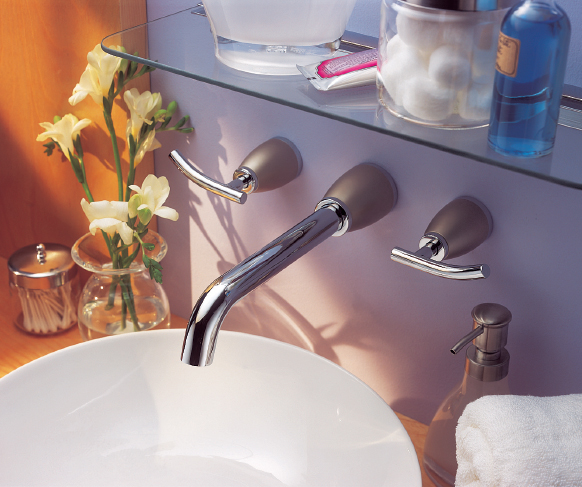
Blending materials such as glass and metal lends dimension to your bath design. Here, the wall-mounted faucet adds a sophisticated touch.
This is also a good time to address future safety problems. For example, choose a bathroom floor that is not slippery when wet. Select medicine cabinets that can’t be opened by small children. Verify your new faucet won’t go from cold to scalding hot for no apparent reason. And remember to include a grab bar for the shower. Don’t worry—you won't ruin your beautiful new bathroom. The newest grab bars are a testament to high style, and they will protect you and your family from dangerous falls. In fact, many top designers insist on including them in every new bath project.
Finally, decide on the overall feeling you want your new bath to conjure. Because your ideal retreat should provide both emotional and physical comfort, consider whether you want your bath to be soft and soothing, subtly elegant, or lively and invigorating. As later chapters discuss how to combine elements such as color, lighting, and materials, you will learn how to construct a space that evokes the responses you desire.
When planning your dream bath, it’s very easy to be seduced by the endless array of choices. How can you not be enticed by a jetted tub that incorporates mood lighting, surround-sound, and Internet access?
It’s important to remember that your design plan should reflect your lifestyle. Sure, that deep soaking tub is gorgeous, but if you haven’t found time for a long soak since 1993, maybe you’d be happier if you chose a spacious shower with all the upgrades.
Similarly, if your morning routine involves six different hair products and enough makeup to stock a department store, stark minimalism is probably not the style for you. Instead, think about incorporating an expansive grooming station with plenty of organized storage areas.
Do you head to your bathroom to relax, rejuvenate, and escape from the rest of the world? If so, why not maximize your precious “me” time with piped-in audio, a sitting area, a deep soaking tub, or even a fireplace? Conversely, if your morning routine is all about speed, choose a shower with temperature presets, so you needn’t waste time fiddling to get the water just right.
Consider maintenance issues, too, especially if your bath will have multiple users. High-gloss surfaces, leather tiles, or intricately styled faucets with lots of tiny crevices all make gorgeous design statements, but they require extra upkeep to keep them looking great.
Remember, your master bath should be a place that helps you unwind; not one that adds more stress to your life; so be sure that your design incorporates all the elements you require for comfort and relaxation.
Is the space cramped or poorly configured? Does it suffer from a lack of storage, light, or counter space? If multiple users share your bath, can two people get ready simultaneously, or do you get in each other’s way?
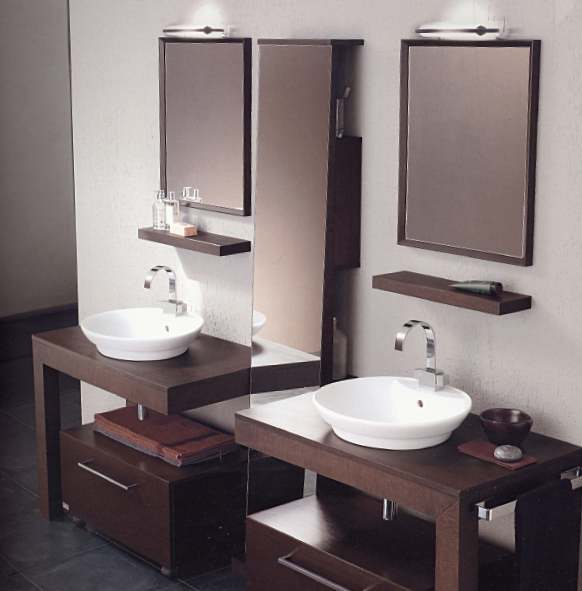
This bath, provides a streamlined look while maintaining separate his and hers spaces to simplify the morning routine.
Once you’ve completed your wish list, it’s time to ponder the question of square footage. Does your new bath meet your space requirements? Is it too small or, even, too large? House plans can be modified prior to construction. Like the old adage that you can never be too thin or too rich, many people assume that you can never have a bathroom that is “too big.” In truth, an overly large space may actually be quite uncomfortable. Just as a tiny room can be confining, a giant area can make you feel exposed and uneasy. What’s more, bathrooms that are too large can echo unpleasantly, creating a feeling of coldness rather than warmth. Obviously, a super-size bathroom can also be a wonderful luxury. Given ample room, you can pick and choose from a host of delightful amenities. Abundant counter and storage space is chief among them, but how about a two-person tub or shower (or both), dual grooming stations, a private bidet, or even a mini-kitchen, exercise area, or spa? Just keep in mind that with a large floor plan, you’ll need to separate your master bath into functional areas, or zones, either through fixture placement or the artful use of color and materials. By doing so, you’ll maintain a sense of warmth, create a better flow, and muffle excess sound. Of course, square footage is not the sole feature that makes a bath luxurious, nor does a shortage of space mean you can’t have a stunning and stylish retreat. If space is at a premium, you still have several options.
Steal from existing space. Talk with a designer, prior to construction, about the many clever ways you can borrow space from an extra bedroom, closet, or hallway, or even create shared closet space between rooms.
Use space-saving products and solutions. If you modify the plans, but are limited to the current footprint, consider such options as a corner tub, pocket doors, wall-mounted faucets, and pedestal sinks, all designed to take up minimal square footage. Replacing an regular tub with a luxurious shower is another increas -ingly popular solution. If your home plan has a second bathroom with a tub you won’t use, this may be an excellent space-saving idea that doesn’t sacrifice anything you really want.
Get creative with storage. Lack of floor space doesn’t mean you can’t have plenty of functional storage. There are many ways to build storage space into your bath that don’t waste precious square footage. These solutions are light years beyond a few shelves above the toilet or a wicker basket on the floor for storing extra towels. For example, there are new cabinet styles that come in an L-shape configuration that sits on two walls, doubling the storage capacity of a standard cabinet. Some new tubs offer built-in storage, and many showers feature recessed niches for soaps and shampoos. There are even full-length, door-hung mirrors on the market that open to reveal storage space for jewelry and medicine.
SMART tip
Conceptualize
The essence of good design begins with the concept. The ambiance, the mood, the palette — all contribute to the success of the space. Think relaxation, luxury, and function when you plan your master bath.
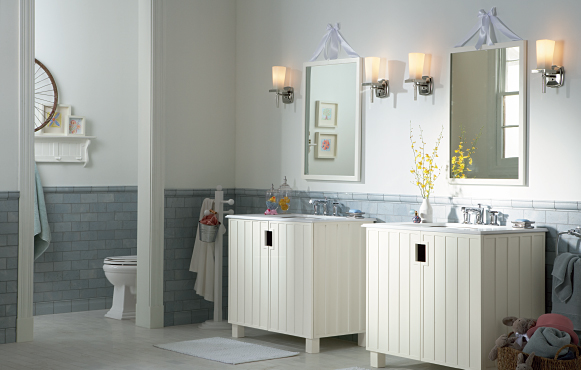
Let your bath transport you to the place you love best, whether it’s a simple beachside cottage or a romantic villa in Tuscany.

Mixing classic white with eye-catching patterned tile in soft shades of brown makes this space feel serene without sacrificing visual interest. Open storage and soft curves add to the bath’s appeal.

If simplicity is your goal, consider built-in storage in the tub surround, an ingenious way to preserve the clean lines of the space.
How do you create the master bath of your dreams? Designer Carol J. Weissman Kurth, AIA, Allied Member ASID, offers these suggestions that pertain to any bathroom:
• Luxury doesn't need to be large. Instead, it's the quality of the space that counts. Interesting ceilings, textures, and details all add to the depth and quality of the design.
• Build upon the theme. Layer and integrate design elements to enhance the architecture of the room and capture your unique personality.
• Display special collectibles. Niches for candles and towels and other creative ideas are all important facets of good bathroom design.
• Eliminate clutter. Cabinetry and places for toiletries ensure that everything is in its rightful place.
• Use a variety of lighting. From task lights for shaving and applying makeup to decorative lights that create magical moods, the importance of the right lighting cannot be overstated.
Not so long ago, bathroom designs fell into very specific categories. There were two major style choices — traditional and contemporary — with a specific delineation between the two that left no room for a middle ground. The prevailing rules of interior decor also dictated that your bathroom had to match the style of the rest of your home, regardless of how well this met your needs.
Thankfully, there has been a growing movement in the last few years toward “transitional” design, which incorporates the best elements of contemporary and traditional styles. Combine this with the equally hot trend of mixing and matching materials, and today’s design choices have become more fluid, not only in a specific room, but also from room to room.
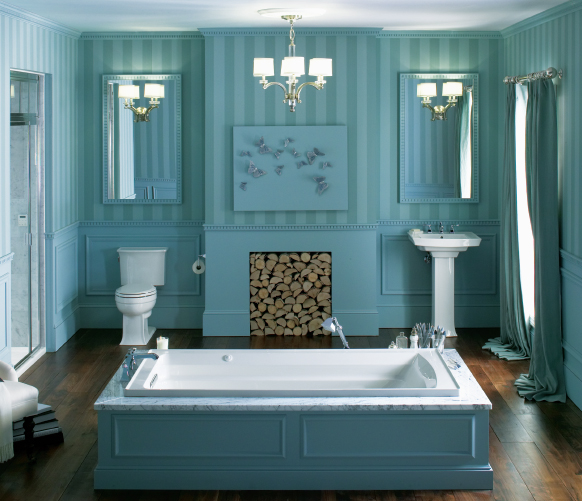
Transitional style is both timeless and versatile, making it a perfect choice to complement almost any decor.

Contrasting the rich warmth of wood with the natural variations of stone adds, depth and dimension to this impressive master bath.
If you decide to modify your home plans bath design, get advice from a professional in the field. When checking out designers, don’t be surprised if the letters after their names read a bit like alphabet soup. Many designers are members of professional associations that help them to further their education and skills. Others pursue special certifications as proof of their knowledge and experience.
How does all this translate into finding the right designer for you? It pays to know what their designations mean. For instance, some associations require little more than annual dues, while others monitor their members to ensure that they maintain high-quality standards. Likewise, certification requirements can range from a specified number of classroom hours to proof of specialized knowledge in a variety of areas. These requirements will vary based on the governing body.
Here are some of the common abbreviations you’ll see and what they mean. For more information about each organization, visit the following Web sites.
| AIA: | Member of the American Institute of Architects; www.aia.org |
| ASID: | Member of the American Society of Interior Designers; www.asid.org |
| CBD: | Certified Bath Designer; www.nkba.org |
| CMKBD: | Certified Master Kitchen and Bath Designer; www.nkba.org |
| CKBR: | Certified Kitchen and Bath Remodeler; www.nari.org |
| CPBD: | Certified Professional Building Designer; www.ncbdc.com |
| CR: | Certified Remodeler; www.nari.org |
| DPHA: | Member of the Decorative Plumbing & Hardware Association; www.dpha.net |
| GCP: | Green Certified Professional; www.nari.org |
| NARI: | Member of the National Association of the Remodeling Industry; www.nari.org |
| NKBA: | Member of the National Kitchen & Bath Association; www.nkba.org |
But why go for “matchy-matchy” when you can layer different textures and materials that add depth, dimension, and your own personal flair? Today, it’s perfectly okay to mix natural stone, bronze, glass, and mahogany or to combine Italian tile with a clean-lined, wall-mounted faucet.
That’s not to suggest that anything goes. Combining a hodgepodge of styles and materials without a basic understanding of design principles can result in a big mess. That’s why it’s a good idea to consult with a qualified design professional for guidance if you decide to modify the bath design on your home plan.
You wouldn’t entrust your health to a guy who sells miracle cures on late-night television. Neither would you assign your master bath redesign to someone who is not a licensed, experienced professional. Hiring a designer with a good track record and strong professional partnerships helps to minimize problems and ensure that your project gets done quickly and efficiently. Interview several designers; study their portfolios; visit jobs they’ve completed; and discuss in detail what you have in mind.

Why not add a bit of “retro” glamour to your private sanctuary? Here, a private grooming nook features an ornately designed mirror and glittery, metallic tiles.